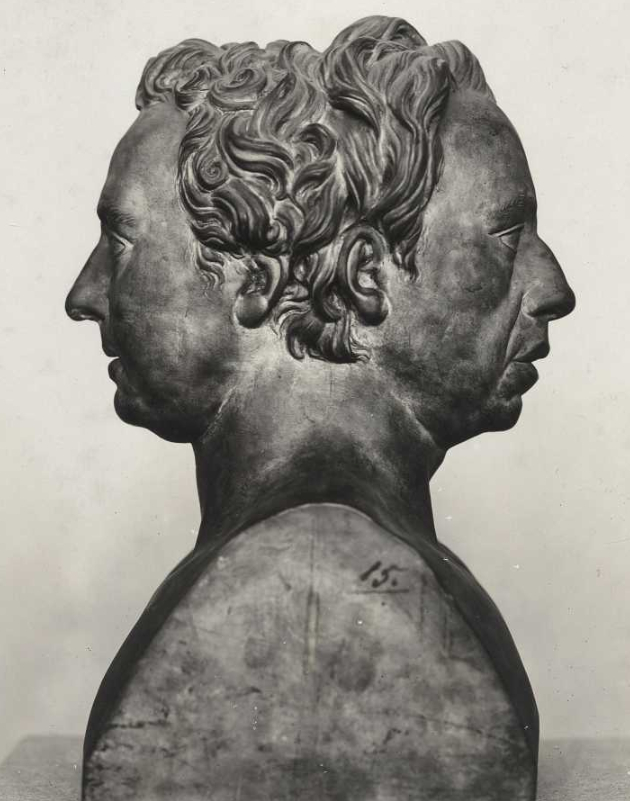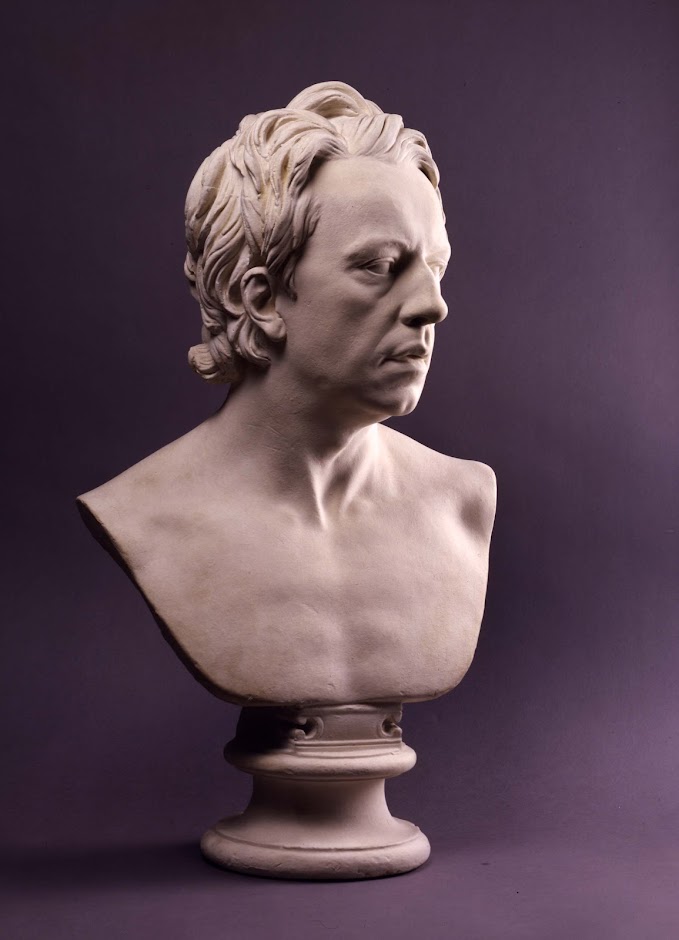(Post under construction).
The Busts of Anton Raphael Mengs.
and José Nicolás de Azara.
Christopher Hewetson (1737 - 99) in Rome (Part 25).
.................
The Herm Janus type bust.
in White Biscuit Terracotta.
Using clay from Monte Soratte near Naples.
28.1 x14 cms.
Giovanni Trevisan called Volpatto (1735 - 1803).
Volpatto was originally an Engraver from Venice.
The Excellent unedited image below from
https://commons.m.wikimedia.org/wiki/File:Giovanni_Volpato,_Erma_con_i_ritratti_di_Anton_Raphael_Mengs_e_Jos%C3%A8_Nicolas_de_Azara.jpg
The portrait of Mengs is based on the bust by Hewetson.
..........................
..........................
A bronze bust of Mengs was placed in the Pantheon by Azara in 1779 to be replaced by a marble (signed and dated 1781) by Hewetson in 1782, this bust was later removed to the Protomoteca Capitolina. Rome.
.............................
Anton Rafeal Mengs. (d.1779).
Marble Bust
Inscribed Hewetson.
National Gallery, Prague.
This signed bust is one of several iterations of this portrait of Mengs.
Hewetson may have begun work on this bust in spring 1779, when he met the painter in his studio.
The meeting took place in the company of Mengs’s friend, the diplomat José Nicolás de Azara.
The first version of this bust is in the Promoteca Capitolina in Rome.
It cannot be ruled out that the Prague bust is identical with the bust that was recorded in 1927 in Vienna.



....................................
Mengs.
Plaster Bust
Christopher Hewetson.
SKD.
............................
Another Plaster Bust of Mengs.
Museo de la Real Academia Bellas Artes San Fernando, Madrid.
From the Captured English Ship The Westmorland.
https://www.academiacolecciones.com/esculturas/inventario.php?id=E-043
From the website.
Google translation!
In 1783, the French captured the Westmorland, an English ship that was coming from Italy carrying a cargo of important works of painting and sculpture in marble and plaster, as well as drawings, books, prints, furniture, etc.
This set of pieces, coming from what was then called the plunder of the English, was brought to Madrid by the Society of Court Longers?. which bought it after the robbery of the captured ship in Malaga.
By Royal Order of April 19, 1784, more than fifty drawers were awarded to the Academy "for public education", which were sent to the capital in two shipments.


For a very in depth look at the restoration of this bust in Spanish see -
https://www.academiacolecciones.com/esculturas/informes/E-043.pdf
see also for the chemical analysis
https://www.academiacolecciones.com/esculturas/informes/E-043_quimico.pdf
The Appearance of the Hewetson Plaster Bust of Mengs in Early 19th Century Inventories etc.
Inventory of the jewelry and furniture existing in the Royal Academy of San Fernando 1804. And continuation of the Inventory that was made in the year 1804, of the jewelry owned by the Royal Academy of San Fernando, 1804-1814. Plaster busts, heads and masks [ f. 78v] "174. Bust of Mengs."
Catalogue of the paintings, statues and busts that exist in the Royal Academy of San Fernando in this year of 1817, Madrid: Fuentenebro, 1817. Library. Busts and statues in the same room [P. 34] "62. Ideam de Don Rafael Mengs".
Catalogue of the paintings, statues and busts that exist in the National Academy of San Fernando in this year of 1821, Madrid: by Ibarra, 1821. Library Room. Busts and statues in the same room [P. 41] "65. Idem, by Don Antonio Rafael Mengs, distinguished Saxon painter."
..............................................
Literature.
AZCUE, Leticia, Sculpture at the Royal Academy of Fine Arts of San Fernando. Catalog and Study , Madrid, 1994, 257.
LUZÓN NOGUÉ, José María (ed.), El Westmorland, memories of the Grand Tour, Madrid, 2002, 358-360, no. 87.
VV.AA., Restauramos , Royal Academy of Fine Arts of San Fernando, Madrid, 2010, 32.
GONZÁLEZ DE AMEZÚA, Mercedes; CIRUELOS GONZALO, Ascension; FERNÁNDEZ BASTOS, Laura; RECIO AGUADO, Rosa Mª, Protagonists of Art. Portraits in the Academy, Royal Academy of Fine Arts of San Fernando , Madrid, 2011, CD ROM.
VV.AA., The English Prize: the capture of the Westmorland, Oxford, 2012, 303, cat. 135.
SCRÖDER, Stephan F.; MAURER, Gudrun, Mengs and Azara. Portrait of a Friendship, Museo Nacional del Prado, Madrid, 2013.
PELLINI, Georgia, "Cristopher Hewetson. Bust of Anton Raphael Mengs", in: DODERO, Eloisa; PARISI PRESICCE, Claudio (eds.), Il Tesoro di Antichità. WincKelmann e il Museo Capitolino nella Roma del Settecento , Gangemi Editore, Italy, 2017, 283-284.
Plaster bibliography:
SUÁREZ HUERTA, Ana María, "A perfect tandem of Neoclassicism: Antón Rafael Mengs and José Nicolás de Azara portrayed by their friend the Irish sculptor Christopher Hewetson", Reales Sitios, no. 185, 18- 43.
KIDERLEN, Moritz, Die Sammlung der Gibsabgüsse von Anton Raphael Mengs in Dresden , Munich, 2006, no. 449.
NEGRETE PLANO, Almudena, "Portrait of Anton Rafael Mengs", in: LUZÓN NOGUÉ, José María (ed.), El Westmorland, memories of the Grand Tour , Madrid, 2002, 358-360, cat. 87.
DODERO, Eloisa; PARISI PRESICCE, Claudio (eds.), Il Tesoro di Antichità. WincKelmann e il Museo Capitolino nella Roma del Settecento , Gangemi Editore, Italy, 2017, 183.
............................
A Bronze bust of Mengs.
Cast by Francesco Righetti (1749 - 1819).
Height 73.7 cms.
The Clarke, Williamstown, Mass. USA.
Acquired 1997.
No provenance on the website!
They say the original which was cast by Righetti was installed in the Pantheon in Rome. Righetti, who worked with Hewetson, cast this version from that original sculpture.
A short note on Francesco Righetti
Francesco Righetti was one of the most prolific sculptors in Rome in the late 18th early 19th centuries. He worked under Luigi Valadier, one of the leading silversmiths in Rome of his day, who also produced high quality copies of bronzes after the Antique.
In 1794 Righetti published a price list of works available for purchase from his workshop, this catalogue illustrates the amazing scope of his business, offering full sized copies of works from the Antique, groups, busts, vases and even replicas of fountains. After a visit to his studio by Pope Pius VII, Righetti became head of the Vatican foundry, his son Luigi becoming his assistant. Righetti's bronzes are renowned for their high quality of casting and finish.
See - Rand, Richard. "Recent Acquisitions (19942005) at the Sterling and Francine Clark Art Institute." The Burlington Magazine 147, no. 1225 (April 2005): 293300.

............................
The Hewetson Mengs Bust
Presumably drawn whilst the bust was briefly set up in the Pantheon.
Tomasso Piroli (c.1750 - 1824).
Engraving.

Note - Mengs' Studio was in the Via Sistina, Rome.
...............................
Miniature of Mengs
by Giuseppe Macpherson.
from the Royal Collection.
https://www.rct.uk/collection/421251/anton-raphael-mengs-1728-1779
.............................
Mengs
Portrait with a bust of Plato.
Christie's, 7 July 2009.
Image courtesy Warburg Institute.
......................
A Portrait of Volpatto
by Angelica Kauffman.
Inscribed u.l.: Joannes Volpato. Incis. celbmo
Signed and dated u.r.: Angelica Kauffman 179…
.................................
Mengs and his Collection of Plaster Casts.
Anton Raphael Mengs (1728–1779) sometimes referred to by his contemporaries as the
‘Raphaele del nostro secolo’.
Among Mengs’s clients were
kings, princes, popes and cardinals.
He was active in Dresden and Madrid, and
above all in Rome, where he assembled one of the largest collections of plaster
casts of classical sculpture. Serving primarily as a source of study material
for young artists, the collection could also be viewed by aristocratic and
learned visitors to the city.
Almost nine hundred of these casts were acquired
by Elector Frederick Augustus III for Dresden in 1782, of which nearly five
hundred are still extant today.
Mengs
left a legacy to King Ferdinand VI of Spain more than a hundred casts that he had in his workshops in Rome and Florence, now in the Royal Academy of Fine Arts of San Fernando, Madrid.
-----------------------
Don Jose Nicola d'Azara, Spanish Ambassador at Rome.
Friend of Mengs,
ChristopherHewetson.
1779.
One of two versions of this bronze.
Azara - "while Mengs was painting a painting commissioned by the king, I was present with Mr. Hewetson, skilled Sculptor, who modeled my portrait under the direction of Mengs himself."
.jpg)
useful website - Winckelman and Spain - Azara.
https://letteraturaartistica.blogspot.com/2019/06/johann-joachim-winckelmann.html









,_by_Christopher_Hewetson,_Rome,_1769_CE._Collector_and_Trustee_of_the_British_Museum._It_is_housed_in_the_British_Muse.jpg)





















































_by_Angelica_Kauffmann.jpg)
.jpg)